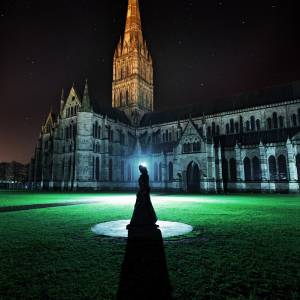Shooting Static Stars - an Experiment
Last night up at Old Sarum Hillfort was the first time I'd been there with a totally cloudless sky. And damned cold it was too!
Now, as you all know, I've done many star-trails up at Old Sarum - and elsewhere - but I wondered about keeping the exposure short enough to keep the stars static.
LARGE
So, taking up the very old and not fully functional FX D700, I took my fastest prime lenses, as speed and maximum aperture would be of the essence. Along with my old Nippon Koguka (pre Nikon Nikkor) 35mm f1.4 and 50mm Nikkor f1.4, I took the fisheye 16mm, as I'd not used this lens up Old Sarum before, the super-wide Sigma 14mm f2.8 and the lens used here - Sigma's 20mm f1.8.
I'd seen many of these starry skies pictures on the 'net and many seem to suffer from poor focus, low contrast and lots of noise. I set out to experiment myself with each lens and at many wider apertures to find out.
ISO speeds that folk seem to use seem to range from 800 to 5,000. How far could I get that down, without compromise?
Shutter speed would be the statutory 30 seconds - any longer and the stars move. With the 50mm lens, on close inspection, the stars do elongate slightly, so 20 secs would be more appropriate. On wide angles, due to the relative smaller size of the stars, this slight movement at 30 secs is not noticeable.
Fast primes usually perform OK wide open but edges lag and corners are often terrible. And focussing accuracy becomes paramount. With such, it's all manual focus and frankly, you cannot see your subject clearly enough. Which brings me to one of my pet hates with modern polycarbonate bodied lenses.
All the EXIF data showed that all my photos were focussed at infinity. But many were slightly out of focus at this setting. In the olden days of metal bodied lenses, an absolute infinity could be guaranteed and the lens' focus ring would stop at true infinity. Look at any of your lenses now and they focus beyond infinity!
Why is this? Because temperature changes makes the plastics in the lens expand and contract. Camera and lens makers presume everyone only uses AF these days, it seems. In my experience, the wider the range of a zoom, the worse they are in this aspect. My Nikkor 18-200mm bears absolutely no relation in actual focussed distance to what shows on the distance scale on the lens. I took it back for repair, it came back no better, but was secondhand and so they felt nothing more could be done. Even the Nikkor 50mm f1.4 doesn't focus accurately at the stated infinity.
Now, when you are focussing manually in the dark and cannot see jot through the viewfinder, it is very helpful if you can shine a torch on the lens and focus via that distance scale - but as I said, this is rarely possible these days.
In actuality, stopping down to a normal aperture, such as f8 covers many focussing discrepancies. But, here, I wanted to shoot wide open and so that was not an option.
So, basically, I got this down to iso 400, at f2. I darkened and gradated the sky down, adding contrast and some sharpness. Out of the several dozen taken in different locations, this is probably my favourite.
It's not an astronomical masterpiece in that it has been processed to get the most out of it and there is still a lot of light pollution. The colour cast on the tree is from Salisbury city's streetlamps, over a mile away.
This exercise has taught me a lot and hopefully my practical experience will assist others too.

Comments New comments are not currently accepted on this journal.